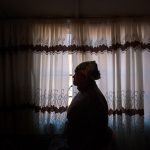The murder crisis in the Western Cape’s ganglands
Statistics reveal that 900 people have been killed in gang-related violence on the Cape Flats so far this year and police volunteers risk suspension by speaking out about it.
Author:
10 July 2019

It was a Saturday afternoon when 72-year-old Sheila Abrahams* began to feel that something was wrong. In her home in Lavender Hill, Cape Town, Abrahams’ family began to worry as they noticed her tongue was swollen. An ambulance was called. But when it finally arrived, gun-wielding gangsters emerged from the nearby streets.
Shots were fired from the young gangsters, who are known to target emergency vehicles for robberies. The ambulance was meant to be accompanied by a police escort, but on that day Abrahams’ family was told there were no police vehicles available. Abrahams’ son-in-law refused to leave her side as gunfire hailed around the ambulance. The paramedics were unable to help the elderly woman. She died at 5pm that afternoon.
“She was one of the founding ladies in Lavender Hill. She was one of the first to move here. One should have celebrated her years, her legacy in Lavender Hill,” said an activist in the area, who did not want to be named out of fear of the gangs.
A surge of intensified gang violence over the past two months has shaken residents in Lavender Hill. Afternoon care for children has been closed during school holidays as a result of the onslaught of shooting, leaving neighbours and grandmothers to look after youngsters while their parents are at work.
Related article:
Grisly truths of mortuary statistics
In the midst of this violence the Western Cape has released statistics, sourced from mortuaries, which indicate that 900 people have been murdered as a result of gang violence on the Cape Flats. In total, 1 600 people have been murdered in the province from the beginning of January to May 2019. Member of the executive council for community safety Albert Fritz described the dire murder rate as a “crisis”.
Another 13 people were shot and killed over the weekend of 6 to 7 July. Six of them were women between the ages of 18 and 26 in the community of Marcus Garvey in Philippi East, according to Fritz. Five men aged 18 to 39, were shot dead in Philippi. While two other people were gunned down in Hanover Park and Delft respectively. The provincial leaders of the community policing forum (CPF) have demanded that Police Minister Bheki Cele meet with them this week to discuss the violence.
Related article:
But the people who have felt the increase in violence are those closest to the ground. The CPF volunteers who work with the police on the Cape Flats have made an unprecedented move. In breaking ranks with the South African Police Service (SAPS) officers with whom they work, they have violated official regulations that state they are not mandated to speak out about police affairs. They now risk suspension.
The Mitchell’s Plain CPF cluster – which includes police stations in Grassy Park, Steenberg, Philippi, Mitchell’s Plain, Strandfontein, Lansdowne, Lentegeur and Athlone – has made a call for Cele to appoint an independent administrator to take over the management of the SAPS in the Western Cape. The cluster has also demanded that the South African National Defence Force (SANDF) be deployed to protect the police and escort emergency services so that officers can focus on policing.
“This is the worst year,” said Gavin Walbrugh, chairperson of the CPF for the Steenberg police station.

Anonymity and the fear of gangsters
In Lavender Hill, most people are scared to reveal their names when speaking out about gang violence because they fear retribution from the gangsters who are their neighbours. But Walbrugh is adamant he wants to say what’s on his mind. He’s well known in Lavender Hill and, as one activist points out, he has the freedom to speak out because he does not live in the area.
Walbrugh works closely with the Steenberg police station, 1km from Lavender Hill. It remains unclear how many people have been killed overall in the area because police crime statistics will only be released in September.
For Walbrugh, however, this is unacceptable. “It’s 900 too much. How many people must be killed before they bring in what we [are] asking for?”
The highest murder rate in South Africa has occurred in the Western Cape and, according to Premier Alan Winde, the figure has risen at an alarming rate in 2019. In 2018, police crime statistics recorded that 3 729 people had been murdered in the province. Between November 2018 and May 2019, the province saw 2 302 murders recorded, according to mortuary statistics.
Full picture in September
Reneilwe Serero, Cele’s spokesperson, has said that the minister will only comment on the murder rate when the annual police crime statistics are released in September.
But the Democratic Alliance (DA) in the Western Cape has taken the ANC-led government to task for its allocation of police resources in the province.
Related article:
“The Western Cape police is dramatically under-resourced compared to other provinces: while one officer must protect 375 people on average nationally, in the Western Cape, the ratio is 1:509,” Winde says.
The DA in the province has long been locked in a political battle with the national ANC government over police resources, with neither party willing to take responsibility for gang warfare and its recent escalation. But community members who live with the violence are fed up.
Policing the police
On 24 June, Sergeant Donovan Prins, 34, approached a group of suspects during the dark cold evening in Lavender Hill. Youngsters hanging out late in the evening in gang territories are cause for suspicion for police officers. Prins had a superb track record of confiscating illegal firearms with his unit at the Steenberg police station and during the routine patrol on that Monday evening, they thought something was amiss.
The young group began firing on the officers as they drew near. Prins’ wife, Shaldene, is also a police officer at the station. She heard the commotion over the police radio as gunfire blasted. And then she listened as her husband was shot.
The sergeant was rushed to hospital, where he died. He has been described as a dedicated police officer who cared for those living in the precincts in which he worked, one of the few cops trusted by the residents of Lavender Hill. His death was a blow.
The CPF cluster in Mitchell’s Plain held a press conference two days after Prins was killed to call on Cele to deploy the SANDF and appoint an independent administrator to manage the Western Cape SAPS.
The CPF in the area has a longstanding reputation of being outspoken on gang violence and policing, but the killings in recent months have made them even more frustrated with the lack of adequate police resources and management.

Army pros and cons
The cluster has asked the SANDF to be deployed to help escort ambulance services and other emergency vehicles so that police officers can focus on policing instead of escorting. They also want the SANDF to act as a buffer to protect the police.
But there is some critique of the deployment of the army. Shaheem de Vries, director of Emergency Medical Services at the Western Cape Health Department, argues against the use of the army because he does not trust that army personnel have been adequately trained to protect emergency services instead of focusing on their enemies.
The CPF cluster in Mitchell’s Plain says there is no other option left.
In the next week, pupils will return to school as the new term starts. But in Lavender Hill, there is uncertainty over if schools will be able to open at all.
With the gun wars continuing and after-school facilities remaining closed during the June holidays, parents are worried that their children may be too afraid to go to classes.
“If this carries on the way it is, schools won’t open,” Walbrugh says.
As the shooting continues, there is still no decision on what action to take to keep residents safe.
*Not her real name



